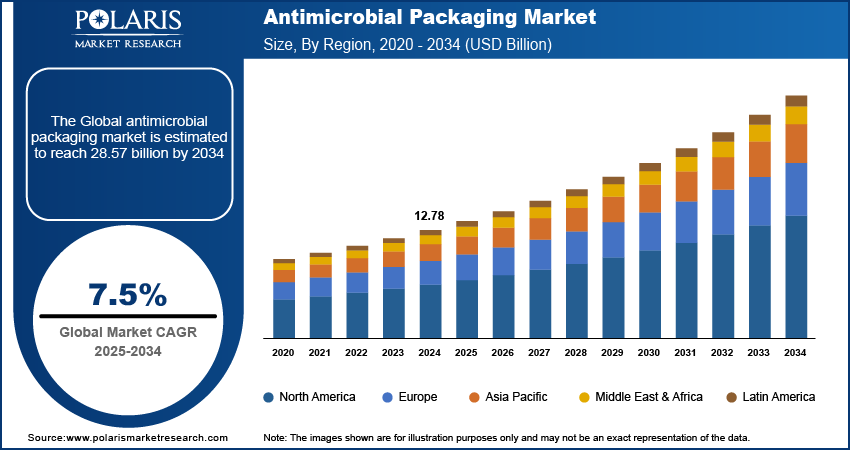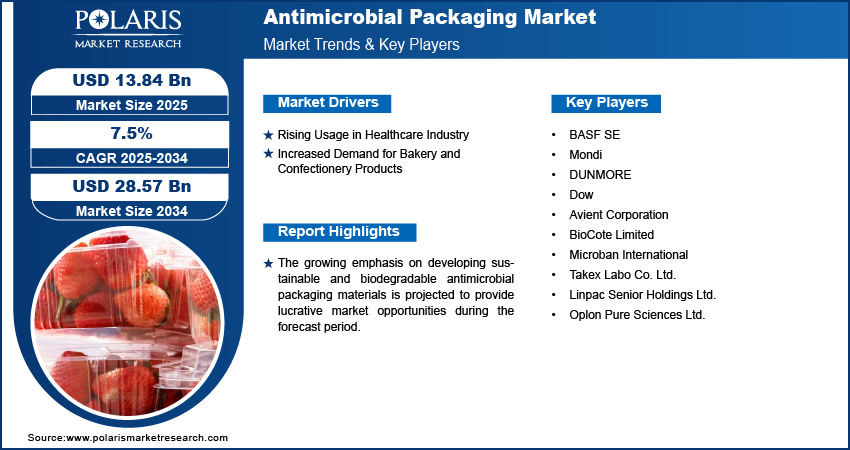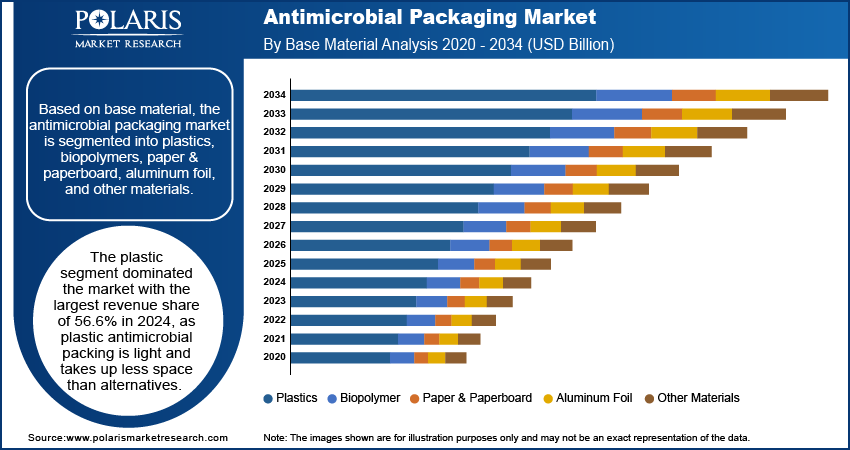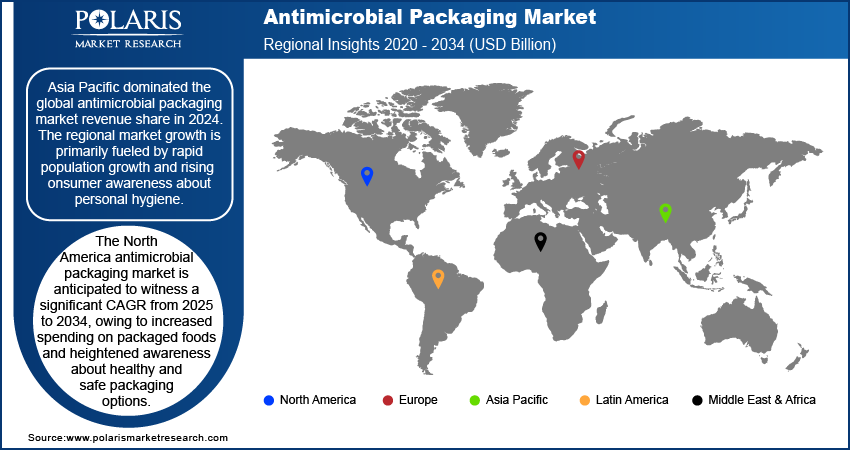
Antimicrobial Packaging Market Size, Share, Trends, Industry Analysis Report: By Pack Type (Bags, Pouches, Trays, Carton Packages, Cups & Lids, and Others), Technology, Base Material, Antimicrobial Agents, End-Use Industry, and Region – Market Forecast, 2025–2034
- Published Date:Jan-2025
- Pages: 117
- Format: PDF
- Report ID: PM1208
- Base Year: 2024
- Historical Data: 2020-2023
Antimicrobial Packaging Market Overview
The global antimicrobial packaging market was valued at USD 12.78 billion in 2024. The market is projected to grow from USD 13.84 billion in 2025 to USD 28.57 billion by 2034. It is projected to exhibit a CAGR of 7.5% from 2025 to 2034.
Antimicrobial packaging is a type of packaging system that uses actively functional polymers or adds active ingredients to control the growth of microorganisms inside the package space. The active ingredients inhibit the growth of microorganisms by reducing their growth rate or extending their lag period. The use of antimicrobial packaging can improve the safety and quality of food products and reduce food contamination risks.

To Understand More About this Research: Request a Free Sample Report
The growing consumption of packaged food is one of the primary drivers of the antimicrobial packaging market growth. The demand for packaged food is propelled by the rising working women population, increasing disposable income, and surging migration rate toward cities. Further, growing consumer preference for clean and virus-free packaging is anticipated to have a positive impact on the antimicrobial packaging market development.
The rising adoption of green product packaging techniques, which employ various materials and production methods to package products with low environmental impact and energy consumption, is one of the market trends anticipated to drive the antimicrobial packaging market demand in the coming years. The growing emphasis on developing sustainable and biodegradable antimicrobial packaging materials is projected to provide lucrative market opportunities during the forecast period.
Antimicrobial Packaging Market Dynamics
Rising Usage in Healthcare Industry
Antimicrobial packaging solutions offer several benefits over conventional materials, such as improved hygiene, sterility, and easy use. The use of antimicrobial packaging in healthcare provides an extra layer of defense against harmful pathogens. The packaging type can also reduce the risk of post-contamination and extend the shelf life of certain products. Also, antimicrobial packaging facilitates the controlled release of antimicrobials, suppressing undesired microbes and offering long-term residual activity. Therefore, the rising utilization of antimicrobial packaging in healthcare facilities drives the antimicrobial packaging market expansion.
Increased Demand for Bakery and Confectionery Products
Antimicrobial packaging improves food safety by inhibiting mold and pathogens such as Salmonella, Listeria monocytogenes, and E. coli. It also helps reduce food wastage by extending the shelf life of bakery products. Further, the use of antimicrobial packaging maintains food quality by preventing undesirable items, such as vapor and pressurized liquids, from infiltrating the package. Thus, the increased demand for bakery and confectionery products, especially in developing economies, is a major contributor to the growing antimicrobial packaging market revenue.

Antimicrobial Packaging Market Segment Insights
Antimicrobial Packaging Market Outlook Based on Base Material
The antimicrobial packaging market, by base material, is segmented into plastics, biopolymers, paper & paperboard, aluminum foil, and other materials. The plastic segment dominated the market with the largest revenue share of 56.6% in 2024. Plastic antimicrobial packing is light and takes up less space than alternatives, resulting in lighter airline and truck payloads and lower emissions. The packaging type is highly adjustable and versatile, allowing manufacturers to customize the form, size, and design to cater to specific consumer needs. It can resist extreme temperatures and does not degrade fast in hot or cold climates, ensuring that the food or beverage inside remains fresh. Products packaged in antimicrobial plastic packaging are also protected from moisture, light, oxygen, dust, and odors.
Antimicrobial Packaging Market Assessment Based on Pack Type
The antimicrobial packaging market, based on pack type, is segmented into bags, pouches, trays, carton packages, cups & lids, and others. The pouches segment accounted for the largest market share in 2024. The segment’s robust growth is primarily attributed to the high versatility and adaptability of pouches. Pouch packing allows customers to tear the pack, which provides an easy opening method. Also, several manufacturers offer pouches with grip seal closures to facilitate easy opening and closing of the pack for recurrent use. Further, pouches are easy to transport, and producers can easily customize them to meet specific requirements.
Antimicrobial Packaging Market Evaluation Based on End-Use Industry
The antimicrobial packaging market, based on end-use industry, is segmented into food & beverages, healthcare, personal care, consumer goods, and other industries. The healthcare segment is anticipated to witness a significant CAGR from 2025 to 2034. Antimicrobial infection is becoming one of the most pressing public health issues of the twenty-first century. The use of antimicrobial packaging can help reduce various types of hospital infections. Thus, antimicrobial packaging is being increasingly used in hospitals, dental offices, nursing homes, and GP offices for items such as beds, cubicle curtains, and nursing call systems for microbial infection control in these settings.

Antimicrobial Packaging Market Regional Analysis
The market report offers antimicrobial packaging market insights into North America, Europe, Asia Pacific, Latin America, and the Middle East & Africa. Asia Pacific dominated the antimicrobial packaging market share in 2024. The regional market growth is primarily fueled by rapid population growth and rising consumer awareness about personal hygiene. The increasing preference for packaged food among teens and adults, the growing incidence of infectious diseases, and rising government funding to strengthen the overall healthcare system further boost the regional market growth.
The North America antimicrobial packaging market is anticipated to witness a significant CAGR from 2025 to 2034. A large percentage of the North American population spends high amounts on packaged foods. Moreover, consumers in the region usually prefer safe packaging, owing to heightened awareness about healthy and safe packaging options. These factors are having a positive impact on the market growth in the region.

Antimicrobial Packaging Market – Key Players and Competitive Insights
The antimicrobial packaging market is characterized by fragmentation. It has the presence of several small and medium-sized companies. The leading market players are making significant investments in R&D to extend their product lines. Also, they are undertaking several strategic initiatives, such as mergers and acquisitions and partnerships, to expand their global reach. To expand and survive in a more competitive environment, the antimicrobial packaging market players must offer innovative solutions.
In recent years, the market for antimicrobial packaging has witnessed several technological and innovation breakthroughs, with key players seeking to provide advanced solutions that help meet sustainability goals. The antimicrobial packaging market report offers a market assessment of all the key players, including BASF SE, Mondi, DUNMORE, Dow, Avient Corporation, BioCote Limited, Microban International, Takex Labo Co. Ltd., Linpac Senior Holdings Ltd., and Oplon Pure Sciences Ltd.
List of Key Companies in Antimicrobial Packaging Market
- BASF SE
- Mondi
- DUNMORE
- Dow
- Avient Corporation
- BioCote Limited
- Microban International
- Takex Labo Co. Ltd.
- Linpac Senior Holdings Ltd.
- Oplon Pure Sciences Ltd.
Antimicrobial Packaging Industry Developments
January 2023: Dow Chemical Company introduced its new high-performance film, Dow INFINIA ProShield HP. The company stated that the film comes with built-in antimicrobial protection for food packaging.
December 2022: BASF announced its collaboration with StePac to develop the next generation of sustainable packaging. According to BASF, the new sustainable packaging solution is specifically aimed at extending the shelf life of fresh produce.
Antimicrobial Packaging Market Segmentation
By Pack Type Outlook
- Bags
- Pouches
- Trays
- Carton Packages
- Cups & Lids
- Others
By Technology Outlook
- Controlled Release
- Active
By Base Material Outlook
- Plastics
- Biopolymer
- Paper & Paperboard
- Aluminum Foil
- Other Materials
By Antimicrobial Agents Outlook
- Organic Acid
- Bacteriocins
- Enzymes
- Essential Oil
- Metal Ions & Oxidizers
- Other Agents
By End-Use Industry Outlook
- Food & Beverages
- Healthcare
- Personal Care
- Consumer Goods
- Other Industries
By Regional Outlook
- North America
- US
- Canada
- Europe
- Germany
- France
- UK
- Italy
- Spain
- Netherlands
- Russia
- Rest of Europe
- Asia Pacific
- China
- Japan
- India
- Malaysia
- South Korea
- Indonesia
- Australia
- Rest of Asia Pacific
- Middle East & Africa
- Saudi Arabia
- UAE
- Israel
- South Africa
- Rest of Middle East & Africa
- Latin America
- Mexico
- Brazil
- Argentina
- Rest of Latin America
Antimicrobial Packaging Market Report Scope
|
Report Attributes |
Details |
|
Market Size Value in 2024 |
USD 12.78 billion |
|
Market Size Value in 2025 |
USD 13.84 billion |
|
Revenue Forecast by 2034 |
USD 28.57 billion |
|
CAGR |
7.5% from 2025 to 2034 |
|
Base Year |
2024 |
|
Historical Data |
2020–2023 |
|
Forecast Period |
2025–2034 |
|
Quantitative Units |
Revenue in USD billion and CAGR from 2025 to 2034 |
|
Report Coverage |
Revenue Forecast, Market Competitive Landscape, Growth Factors, and Trends |
|
Segments Covered |
|
|
Regional Scope |
|
|
Competitive Landscape |
|
|
Report Format |
|
|
Customization |
Report customization as per your requirements with respect to countries, regions, and segmentation. |
FAQ's
The antimicrobial packaging market size was valued at USD 12.78 billion in 2024 and is projected to grow to USD 28.57 billion by 2034.
The antimicrobial packaging market is projected to register a CAGR of 7.5% from 2025 to 2034.
Asia Pacific accounted for the largest region-wise market size in 2024.
BASF SE, Mondi, DUNMORE, Dow, Avient Corporation, BioCote Limited, Microban International, Takex Labo Co. Ltd., Linpac Senior Holdings Ltd., and Oplon Pure Sciences Ltd. are a few key players in the market.
The plastic segment accounted for the largest market share in 2024.
The pouches segment dominated the market for antimicrobial packaging.
